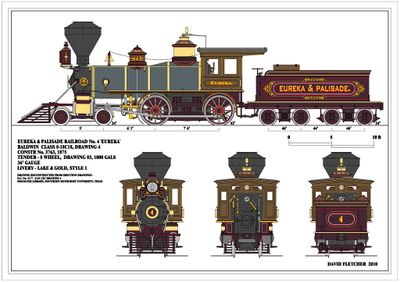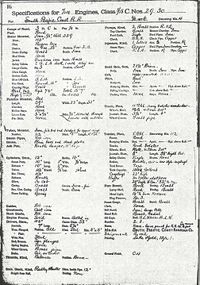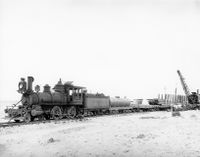Difference between revisions of "BLW-CN3971-1876"
| (15 intermediate revisions by 2 users not shown) | |||
| Line 1: | Line 1: | ||
{{DISPLAYTITLE:South Pacific Coast | [[Narrow_Gauge_Railroads_of_California|California]] / [[Narrow_Gauge_Railroads_of_California#Common Carrier|Common Carrier]] / [[South Pacific Coast Railroad]] / [[South Pacific Coast Railroad Locomotive Roster|Locomotives]]<br> | ||
[[Narrow Gauge Railroads of California|California]] / [[Narrow Gauge Railroads of California#Common Carrier|Common Carriers]] / [[Colusa and Lake Railroad]] / [[Colusa & Lake Railroad Locomotive Roster|Locomotive Roster]] | |||
{{DISPLAYTITLE:South Pacific Coast Railroad No. 3}} | |||
==History== | ==History== | ||
Built by the Baldwin Locomotive Works in 1876 for the [[South Pacific Coast Railroad]] of California. | Built by the Baldwin Locomotive Works in 1876 for the [[South Pacific Coast Railroad]] of California. | ||
| Line 32: | Line 34: | ||
{| | {| | ||
|Baldwin Class | |[[Baldwin_Locomotive_Works| Baldwin Class]] | ||
|8-18C 30, Drawing 4. | |8-18C 30, Drawing 4. | ||
|- | |- | ||
| Line 38: | Line 40: | ||
|[[4-4-0]] | |[[4-4-0]] | ||
|- | |- | ||
|UIC | |[https://en.wikipedia.org/wiki/UIC_classification_of_locomotive_axle_arrangements UIC] | ||
|2′B n | |2′B n | ||
|- | |- | ||
| Line 60: | Line 62: | ||
|- | |- | ||
|Cylinder Size | |Cylinder Size | ||
|12 in × 16 in ( | |12 in × 16 in (305 mm × 410 mm) | ||
|- | |- | ||
|} | |} | ||
| Line 74: | Line 76: | ||
====South Pacific Coast==== | ====South Pacific Coast==== | ||
Ordered by the [[South Pacific Coast Railroad]] in June 1876. | Ordered by the [[South Pacific Coast Railroad]] in June 1876. Converted to a coal burner October 1880. Transferred to the [[South Pacific Coast Railway]] May 1887. The locomotive was significantly damaged in May 1890 after plunging into the Oakland Estuary via the open Webster Street Bridge. The headlight, stack, sandbox, outer steam dome, boiler jacket, and cab were ripped off the locomotive. Converted to fuel oil after November 1902. | ||
====Colusa & Lake==== | ====Colusa & Lake==== | ||
[[File:Colusa and Lake Eng 4 019 Unk Photographer.jpg| | [[File:Colusa and Lake Eng 4 019 Unk Photographer.jpg|200px|right|thumb|C&L #4 stored in Colusa after the railroad shut down.]] | ||
The locomotive was sold to the [[Colusa & Lake Railroad]] in 1906 when the Southern Pacific Railroad had begun liquidating the remaining narrow gauge equipment from the South Pacific Coast | The locomotive was sold to the [[Colusa & Lake Railroad]] in 1906 when the Southern Pacific Railroad had begun liquidating the remaining narrow gauge equipment from the South Pacific Coast Railway. On the Colusa & Lake it became #4. After the 1906 San Francisco Earthquake the Colusa & Lake Railroad saw an increase in revenue as Colusa Sandstone was in high demand for rebuilding San Francisco. A decade later the revenue was nearly gone, the Colusa & Lake had two standard gauge competitors into Colusa and the railroad filed for abandonment in 1917. The railroad's equipment was stored along the railroad and #4 remained in Colusa on the edge of town for a time, even appearing in a number of candid photographs taken by travelers. | ||
====United Commercial==== | ====United Commercial==== | ||
[[File:UCC-ad-CL-4-Pacific-Marine-Review.jpg| | [[File:UCC-ad-CL-4-Pacific-Marine-Review.jpg|250px|left|thumb|Former C&L # listed for sale in October 1918.]] The United Commercial Company of San Francisco purchased the remains of the Colusa & Lake Railroad for scrapping. Several pieces of equipment had been sold to the Eureka - Nevada Railway and the remaining equipment was taken the [[United Commercial Company]]'s scrapyard in San Francisco. An advertisement mentioned in the Pacific Marine Review of October 1918 listed two Baldwin Locomotives, thirty-six flat cars and eight box cars for sale. | ||
<br/> | |||
<br/> | |||
<br/> | |||
<br/> | |||
<br/> | |||
<br/> | |||
====United States Gypsum==== | |||
[[Image:USG-const-UCC-4-CL-flats.jpg|200px|right|thumb|Locomotive #4 during construction of the railroad]] Locomotive #4 and several flat cars were finally sold to the [[United States Gypsum Company]] and used in the construction of their railroad from Plaster City to the [[:category:gypsum|Gypsum]] deposits to the north west. The locomotive was replaced by larger equipment after the line was completed and eventually scrapped. | |||
[[Category:Baldwin Locomotives]] [[Category:4-4-0]] | |||
[[ | |||
Latest revision as of 18:48, 11 January 2023
California / Common Carrier / South Pacific Coast Railroad / Locomotives
California / Common Carriers / Colusa and Lake Railroad / Locomotive Roster
History
Built by the Baldwin Locomotive Works in 1876 for the South Pacific Coast Railroad of California.
Specifications
| Baldwin Class | 8-18C 30, Drawing 4. |
| Whyte | 4-4-0 |
| UIC | 2′B n |
| Gauge | 3 ft (914 mm) |
| Driver Dia. | 42 in (1,067 mm) |
| Loco weight | 22 short tons (20.0 t) |
| Fuel Type | Wood |
| Boiler Pressure | 120 psi (0.83 MPa) |
| Cylinders | Two, outside |
| Cylinder Size | 12 in × 16 in (305 mm × 410 mm) |
Service
South Pacific Coast
Ordered by the South Pacific Coast Railroad in June 1876. Converted to a coal burner October 1880. Transferred to the South Pacific Coast Railway May 1887. The locomotive was significantly damaged in May 1890 after plunging into the Oakland Estuary via the open Webster Street Bridge. The headlight, stack, sandbox, outer steam dome, boiler jacket, and cab were ripped off the locomotive. Converted to fuel oil after November 1902.
Colusa & Lake
The locomotive was sold to the Colusa & Lake Railroad in 1906 when the Southern Pacific Railroad had begun liquidating the remaining narrow gauge equipment from the South Pacific Coast Railway. On the Colusa & Lake it became #4. After the 1906 San Francisco Earthquake the Colusa & Lake Railroad saw an increase in revenue as Colusa Sandstone was in high demand for rebuilding San Francisco. A decade later the revenue was nearly gone, the Colusa & Lake had two standard gauge competitors into Colusa and the railroad filed for abandonment in 1917. The railroad's equipment was stored along the railroad and #4 remained in Colusa on the edge of town for a time, even appearing in a number of candid photographs taken by travelers.
United Commercial
The United Commercial Company of San Francisco purchased the remains of the Colusa & Lake Railroad for scrapping. Several pieces of equipment had been sold to the Eureka - Nevada Railway and the remaining equipment was taken the United Commercial Company's scrapyard in San Francisco. An advertisement mentioned in the Pacific Marine Review of October 1918 listed two Baldwin Locomotives, thirty-six flat cars and eight box cars for sale.
United States Gypsum
Locomotive #4 and several flat cars were finally sold to the United States Gypsum Company and used in the construction of their railroad from Plaster City to the Gypsum deposits to the north west. The locomotive was replaced by larger equipment after the line was completed and eventually scrapped.






